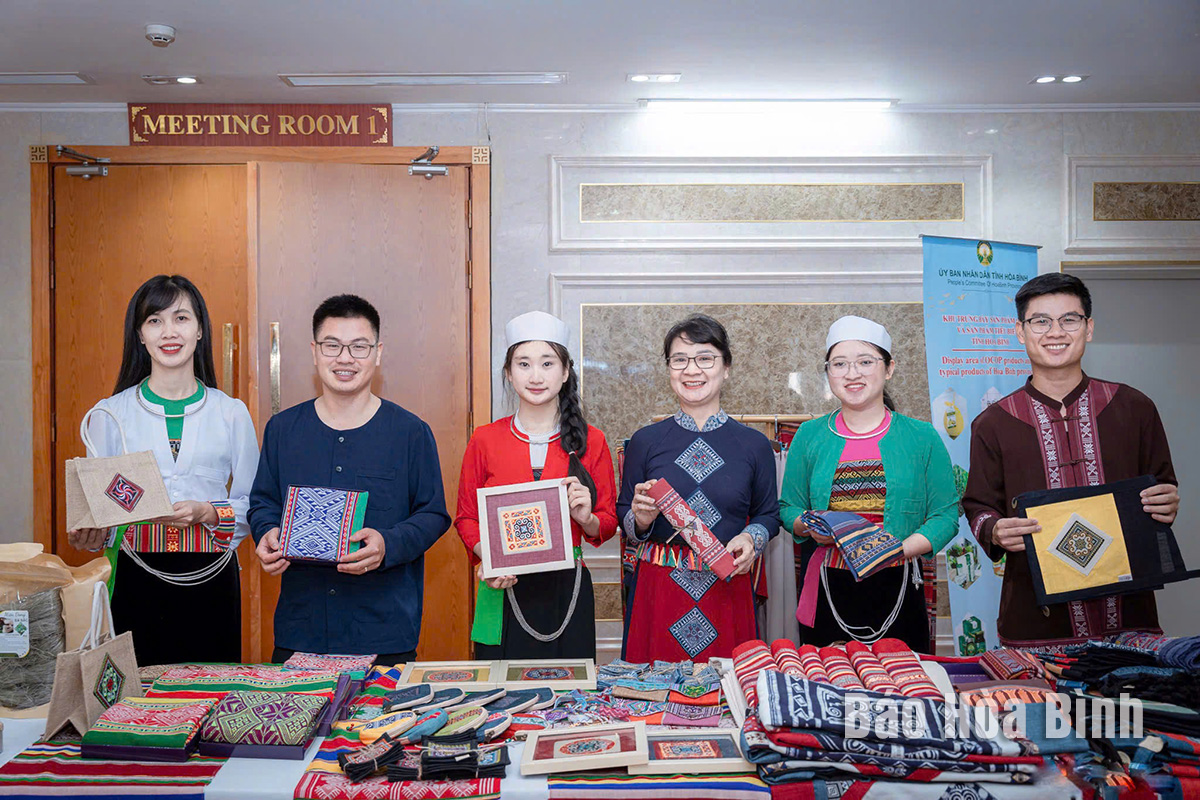
In the context of globalisation and deeper integration, preserving and promoting the national cultural identity is of utmost importance. Aware of their pioneering and proactive role on all fronts, over the years, the youth organisations at all levels in Hoa Binh province have implemented various concrete and practical activities to preserve and promote the cultural identities of ethnic groups in the locality.
The youth club for preserving and promoting ethnic cultural identity of the province, in collaboration with Hoa Dat Muong store (Hoa Binh city), introduces outstanding local cultural products at the "Meet India" programme in 2024 organised by the provincial People's Committee.
Hoa Binh is home to various ethnic groups, namely Muong, Kinh, Thai, Dao, Tay, and Mong. Each has its own customs, beliefs, and heritage values of literature and arts, language, writing and folk knowledge, and unique traditional costumes. The province is also renowned for the world-famous Hoa Binh Civilization, the cradle of the ancient Vietnamese culture.
Over recent years, the province has paid attention to and directed the work of preserving and developing the culture of ethnic minorities.
However, in the era of Industry 4.0, there are numerous difficulties and challenges. Many cultural values of the Muong ethnic group and the "Hoa Binh Civilisation" face the serious risk of being lost.
Nguyen Van Doan, head of the youth club for preserving and promoting ethnic cultural identity of the province, stated that with their pioneering and proactive role, technology skills, and ability to access information, local young people and youth union members have effectively utilised digital platforms to spread and promote ethnic culture. Many have used social media platforms such as Zalo, TikTok, and Facebook to introduce their customs, traditions, and cultural heritage to a large audience both domestically and internationally. Notably, they have effectively used digital technology to showcase the beautiful landscapes and distinctive cultural features of the ethnic groups in the province to tourists.
In addition, local youths have pioneered in digital transformation, building and applying QR codes at historical and cultural relic sites to provide information about and automated interpretation of the province’s culture and tourism for residents and tourists.
Nguyen Duy Tu, Secretary of the provincial Ho Chi Minh Communist Youth Union, said that through practical actions, union members and youth in the province have consistently raised their awareness and sense of responsibility in preserving and promoting traditional cultural values. They have been the core force in efforts to preserve and promote ethnic cultural identity.
Phong Phu commune, Tan Lac district of Hoa Binh province, is widely regarded as the cultural heartland of the Muong ethnic group. Among its many traditional communities, Luy Ai hamlet (formerly Ai hamlet) stands out as a rare location where the customs and way of life of the Muong Bi people remain largely intact.
The Truong Kha temple festival, a distinctive cultural event held every three years in Vu Ban township, Lac Son district, returned recently with vibrant rituals and folk traditions of the Muong people. Located next to the Buoi River in the Muong Trao fields, the Truong Kha Temple is dedicated to the three Kun Dol deities, revered for teaching farming techniques, irrigation, weaving, and protecting the harvest.
The demand for spaces serving community activities of residents in various areas across Hoa Binh city has been satisfied as local cultural houses now feature modern, spacious facilities thanks to the effective implementation of Resolution No. 49/NQ-HDND issued on December 28, 2021 by the city People's Council, which approved the plan for reorganising, converting, and allocating land for the construction, repair, and expansion of cultural houses in Hoa Binh’s villages and residential areas until 2025.
At the end of May, the Hoa Binh Provincial Ethnic Arts Troupe organized a series of performances for residents in Region 2 and Region 3 communes across the province. Bringing art to ethnic communities in remote, isolated, and especially disadvantaged areas has become a meaningful activity. These are not merely artistic performances but also journeys to disseminate cultural values, enrich spiritual life, and contribute to preserving the cultural identity of ethnic minorities.



